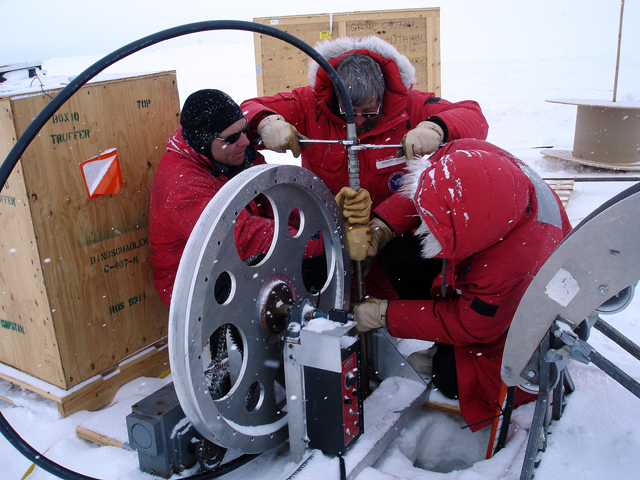|
Page 2/2 - Posted October 8, 2010
Ridge is a game-changer“The ridge has changed the show,” said Tim Stanton The ridge is a game-changer because it means that any deployment of the ocean profiler upstream of the ridge — remember that the ice flows toward the ocean — might have hit the raised seafloor. Now any upstream deployment of the instrument package will have to account for the ridge. The ridge was discovered in 2009 during a research cruise aboard the USAP’s Nathaniel B. Palmer A British team aboard the ship sent a robotic submarine underneath the ice shelf where it mapped various properties of the underwater cavity, discovering the ridge along the way. [See previous article: Rapid retreat.] “It was really a blessing to have that information. Otherwise, it was a blank slate,” Bindschadler said of the data retrieved by the yellow submarine. “The annoying thing about the ridge is that our instruments can’t touch the floor.” The British are also collaborators on the PIG project. A British Antarctic Survey (BAS) “[Pine Island] has been a focus for us for quite a few years,” said David Vaughan Two American teams will also head to the Ice this season on separate missions. David Holland Director of the Center for Atmosphere Ocean Science at New York University Meanwhile, Stanton and a separate team will join New Zealand researchers at a field camp near Erebus Ice Tongue, a glacier that pokes out about 10 kilometers into McMurdo Sound from the Ross Island coastline near Cape Evans. The U.S. scientists will conduct a second test of the ocean profiler system on the sea ice. Last year’s “dress rehearsal” of the project successfully punched through the 200-meter-thick section of ice shelf near McMurdo Station with a hotwater drill. [See previous article: Dress rehearsal.] It was the first time scientists had deployed such a complex ocean profiler beneath an Antarctic ice shelf, even discovering a wee marine organism with a borehole camera that preceded the profiler down the fresh hole. However, the system malfunctioned shortly after the team left. Stanton believes he has worked out the problem and wants another shot at testing the equipment before the team does it for real in about a year. By then there will be little room for mistakes among the crevasse fields of the Pine Island Glacier Ice Shelf. “We’re going to be eager to bang this camp in,” Stanton said. NSF-funded research in this story: Robert Bindschadler and Alberto Behar, Goddard Space Flight Center, Award No. 0732906 |



For USAP Participants |
For The Public |
For Researchers and EducatorsContact UsU.S. National Science FoundationOffice of Polar Programs Geosciences Directorate 2415 Eisenhower Avenue, Suite W7100 Alexandria, VA 22314 Sign up for the NSF Office of Polar Programs newsletter and events. Feedback Form |





